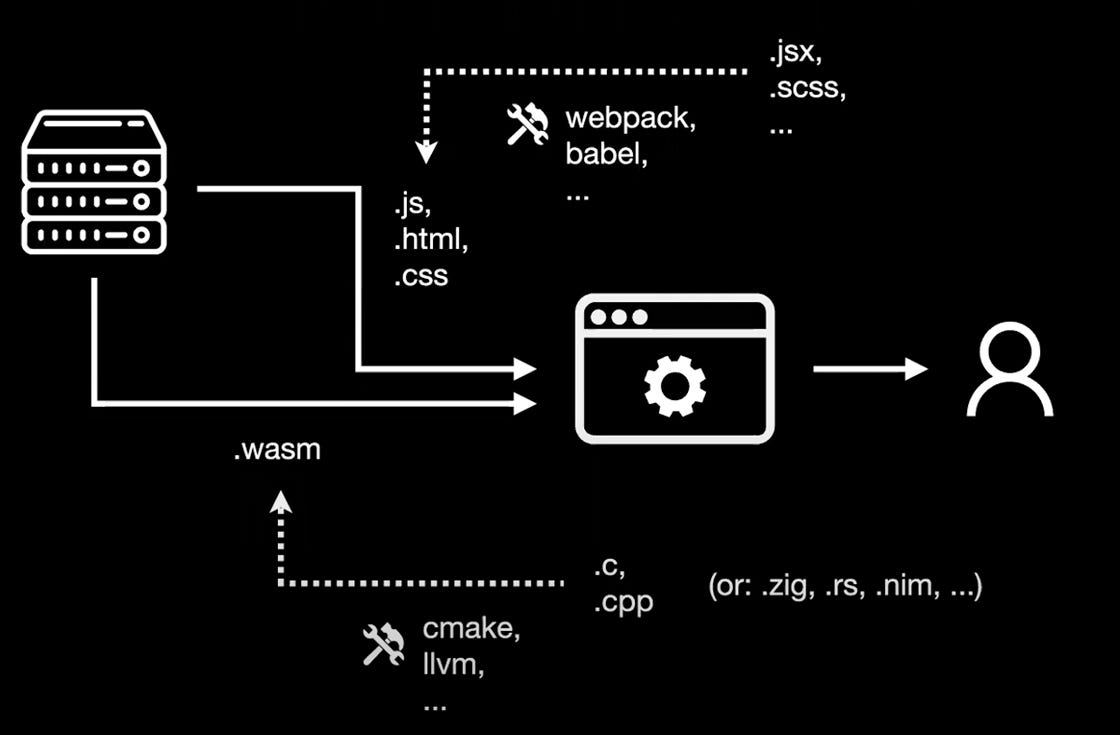At its core, WebAssembly is a binary, compiled instruction format optimized for machines to run. Think of it not as a language you write directly by hand, but as a low-level target format that other programming languages compile to.
This is similar to how you might write code in JSX for React or use Sass for CSS, which then get processed by build tools (like Webpack or Babel) into something the browser can execute. WebAssembly, with its standard .wasm file extension, simply adds one more file type that modern browsers are designed to understand and execute efficiently.
Where WebAssembly Fits in the Web Stack
Traditionally, a web browser interacts with a server by receiving and interpreting HTML, CSS, and JavaScript files to deliver an experience to the user. The browser acts as an interpreter and a virtual machine for this code. WebAssembly introduces .wasm files into this pipeline.
So, how do you create a .wasm file? You typically write code in a different programming language, such as Rust. Other languages like Zig, C++, and Nim are also opening up to target WebAssembly. You then use a suite of tools, including a compiler and build system, to generate the .wasm file that your server sends to the browser. Some languages can compile directly to WebAssembly using tools like LLVM (used by Zig and Rust), while others might compile to an intermediate language first (like Nim compiling to C)
The Key Benefits of WebAssembly
Why go through this extra compilation step? The primary motivation is performance. While JavaScript is excellent for many tasks, especially those involving user interfaces and high-level interactions, it has limitations when it comes to performance-critical code. WebAssembly offers significant advantages in this area:
Control Over Memory Layout: In JavaScript, you're largely confined to using its object model, with limited guarantees about how data is stored in memory. This can lead to data being scattered, impacting CPU cache efficiency. Languages compiled to WebAssembly, like C or C++, give you explicit control over memory layout. Data structures like structs can guarantee that related data (like a player's health, position, and score) are located next to each other in memory. This spatial locality is crucial because CPUs can read memory located near recently accessed memory much faster, a technique leveraged by the CPU's cache.
Optional Garbage Collection: JavaScript enforces the use of a garbage collector (GC)5. While generally helpful, GC pauses can sometimes cause performance hiccups in demanding applications like games. Developers often resort to complex manual techniques like object pooling in JavaScript to work around this. WebAssembly provides the choice of whether or not to use garbage collection. Languages like C++ allow manual memory management, giving developers fine-grained control, while other languages that compile to Wasm, like Go, still utilize GC.
Compiler Optimizations: Compilers used for languages like C++ (such as LLVM, which has decades of optimization effort) can perform sophisticated code analysis and transformations that lead to faster execution. These include optimizing mathematical operations, inlining small functions to reduce overhead, and leveraging static typing information to generate more efficient machine code compared to dynamically typed languages like JavaScript, which must perform runtime checks.
Beyond raw speed, WebAssembly offers other compelling benefits, particularly relevant for game development:
Code Sharing Across Platforms: A major advantage is the ability to write the same core code for both native applications (like mobile apps on iOS and Android) and web applications. For game engines that rely on graphics APIs like OpenGL, the calls are often the same whether made from C++ running natively or compiled to WebAssembly. This allows teams to maintain a single codebase for the engine that can be compiled for different platforms. For example, the engine for the app Castle was rewritten in C++ to target both mobile and web.
Access to Existing Libraries: WebAssembly unlocks the vast ecosystem of existing libraries written in languages like C and C++. For domains like game development, where libraries for physics pathfinding, and linear algebra are abundant in C/C++, this means developers don't have to reinvent the wheel. Libraries that are purely computational and don't rely on external system connections are particularly easy to port to WebAssembly.
Language Exploration: It provides developers with the freedom to explore and use different programming languages beyond JavaScript for parts of their web application.


